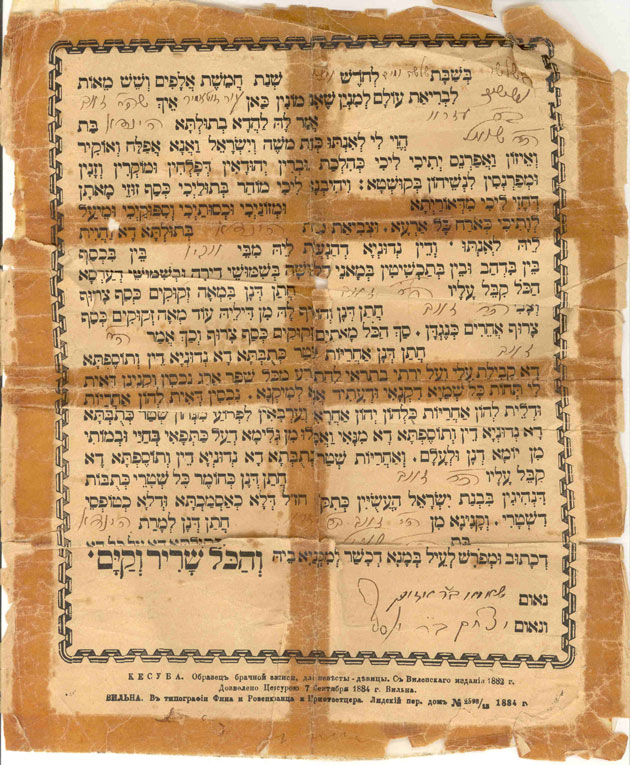מײַן באַליבטסטע ירושה־זאַך: מײַן עלטער־זיידנס כּתובה
Favorite Heirloom: Great-Grandfather's Wedding Contract
פֿון שלמה־חיים כּהן
SCROLL DOWN FOR ENGLISH
מיט עטלעכע חדשים צוריק האָבן מיר געבעטן אונדזערע לייענער — סײַ פֿונעם ייִדישן פֿאָרווערטס, סײַ פֿונעם ענגלישן — איר זאָלט אונדז צושיקן אַ פֿאָטאָגראַפֿיע און באַשרײַבונג פֿון אײַער באַליבטסטער ירושה־זאַך. דער אָפּרוף איז געווען אַן ענטוזיאַסטישער. אָנהייבנדיק די ערשטע וואָך אין מײַ, דעם חודש געווידמעט דער ייִדישער אַמעריקאַנער קולטור־ירושה, שטעלן מיר יעדן טאָג אַרויף איינע פֿון די ירושה־מעשׂיות.
דורך די אַלע חפֿצים וועט איר זיך אַ ביסל דערוויסן וועגן די אינטערעסאַנטע משפּחה־געשיכטעס פֿון אונדזערע לייענער, און במילא זיך באַקענען מיט געוויסע אַספּעקטן פֿון דער ייִדישער קולטור־געשיכטע פֿון אַ מער פּערזענלעכן קוקווינקל.
מײַן עלטער־זיידנס כּתובה
שלמה־חיים כּהן (הײַטסטאַון, ניו־דזשערזי)
דאָס איז מײַן עלטער־זײדע־באָבעס כּתובה פֿונעם יאָר 1900 אין זשיטאָמיר, אוקראַיִנע. דער חתן, װעלװל (זאבֿ) קיגעל, וואָס איז געבױרן געוואָרן אינעם שטעטל איװניצע (אוקראַיִנע) אין 1880, האָט װײניק דערצײלט זײַנע קינדער װעגן זײַן הינטערגרונט. אַפֿילו זײַן פֿאַמיליע־נאָמען, קיגעל, איז ניט געבליבן אין דער משפּחה װײַל נאָכן קומען קײן ניו־יאָרק האָט ער אים געביטן אויף „קאָהען‟. (איצט, חבֿרה, ווייסט איר אַז איך בין אַ „פֿאַלשער כּהן!‟)
פֿון אַלטע הײם־געמאַכטע־פֿילמען פֿון די 1940ער און 50ער יאָרן זע איך אַז וועלוול האָט געהאַט העל־בלאָע אױגן. איך װײס אויך אַז ער און זײַנע זין האָבן געהאַט גראָבע הענט. ביז װעלװל איז געשטאָרבן אין 1955 פֿלעג מײַן טאַטע לייענען צוזאַמען מיט אים דעם „פֿאָרװערטס‟.
די כּלה, הינדע פּאָליאַק, האָט אָבער געהאַט אַ גרױסע משפּחה פֿון זשיטאָמיר — הײַנט באַטרעפֿן זיי אין די הונדערטער. הינדע איז געבױרן געװאָרן אין 1876 (יאָ, זי איז געווען עלטער פֿון איר מאַן!) אין קאָדניע, אַ דערפֿל אַ ביסל אויף דרום פֿון זשיטאָמיר, און נאָך דער חתונה זײַנען חתן־כּלה דאָרטן פֿאַרבליבן. זייער זון, מײַן זײדע, װאָס איז געקומען קײן אַמעריקע צו 10 יאָר אין 1914, פּונקט פֿאַר דער מלחמה, האָט מיר דערצײלט װעגן זײער געוואַלדיקער אָרעמקײט אין קאָדניע: זיי האָבן געוווינט אין אַן אײן־צימערדיקער שטוב אין איינעם מיט די בהמות און פֿאַרם־חיות, און ווינטערצײַט זענען זיי געשלאָפֿן אויפֿן פּריפּעטשיק. ניט פֿון האָלץ איז געװען די פּאָדלאָגע, נאָר פֿון ערד, און יעדן ערבֿ־שבת פֿלעג די עלטער־באָבע הינדע באַשיטן די ערד מיט רױטער ציגל־פּראָשיק. הינדע איז געשטאָרבן אין ניו־יאָרק אין 1954.
Several months ago we asked you, readers of the Yiddish and English Forward, to send us a photo and description of your favorite heirloom. The response was an enthusiastic one. Beginning the first week of May, Jewish American Heritage Month, we will publish each of these stories daily on our website.
By reading about these family treasures, you will discover some of the fascinating family histories of our readers, as well as their Jewish cultural context from a personal perspective.
If you can read some Yiddish, try reading the Yiddish passage above, which comes with a special feature: every time you click on a word, the English translation appears!
My Great-Grandfather’s Wedding Contract
by Stephen Cohen (Hightstown, NJ)
This is my great-grandfather’s kesube, wedding contract, from the year 1900 in Zhitomir, Ukraine. The groom, Velvl (Zev) Kigel, who was born in the shtetl of Ivnitse, Ukraine in 1880, told his children very little about his background. Even his last name, Kigel, didn’t stay in the family because after immigrating to NY, he changed it to Cohen. (So yes, my friends, I’m not really from the priestly class.)
Watching home movies made in the 1940s and 50s, I noticed that Velvl had bright blue eyes. I know that he and his sons also had thick hands. Until Velvl died in 1955, my father of blessed memory would read the Forverts together with him.
His bride, Hinde Pollak, on the other hand, had a large family in Zhitomir, numbering in the hundreds today. Hinde was born in 1876 (yes, she was older than her husband!) in Kodnye, a village south of Zhitomir, and after the wedding, they remained there. Their son, my grandfather, who emigrated to America at 10 years of age in 1914, right before the outbreak of World War I, told me stories about their extreme poverty in Kodnye: they lived in a one-room house, together with their cattle and other farm animals, and used the hearth as a bed during the cold winter nights. There was no wooden floor, just the earth beneath their feet. Every week before shabbos, my great-grandmother Hinde would sprinkle the earth with red brick dust. Hinde died in NY in 1954.






